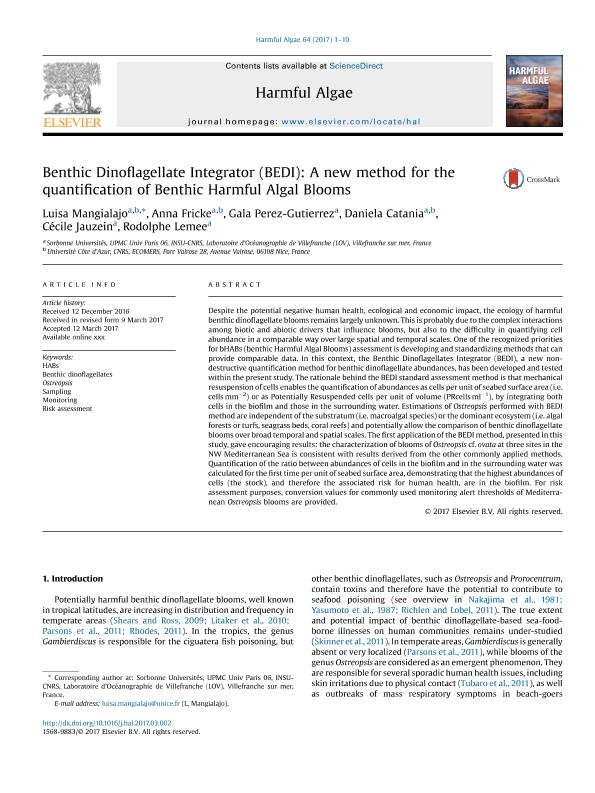Mostrar el registro sencillo del ítem
dc.contributor.author
Mangialajo, Luisa
dc.contributor.author
Fricke, Anna Lena

dc.contributor.author
Perez Gutierrez, Gala
dc.contributor.author
Catania, Daniela
dc.contributor.author
Jauzein, Cécile
dc.contributor.author
Lemee, Rodolphe
dc.date.available
2018-02-27T15:06:33Z
dc.date.issued
2017-04
dc.identifier.citation
Mangialajo, Luisa; Fricke, Anna Lena; Perez Gutierrez, Gala; Catania, Daniela; Jauzein, Cécile; et al.; Benthic Dinoflagellate Integrator (BEDI): A new method for the quantification of Benthic Harmful Algal Blooms; Elsevier Science; Harmful Algae; 64; 4-2017; 1-10
dc.identifier.issn
1568-9883
dc.identifier.uri
http://hdl.handle.net/11336/37242
dc.description.abstract
Despite the potential negative human health, ecological and economic impact, the ecology of harmful benthic dinoflagellate blooms remains largely unknown. This is probably due to the complex interactions among biotic and abiotic drivers that influence blooms, but also to the difficulty in quantifying cell abundance in a comparable way over large spatial and temporal scales. One of the recognized priorities for bHABs (benthic Harmful Algal Blooms) assessment is developing and standardizing methods that can provide comparable data. In this context, the Benthic Dinoflagellates Integrator (BEDI), a new non-destructive quantification method for benthic dinoflagellate abundances, has been developed and tested within the present study. The rationale behind the BEDI standard assessment method is that mechanical resuspension of cells enables the quantification of abundances as cells per unit of seabed surface area (i.e. cells mm−2) or as Potentially Resuspended cells per unit of volume (PRcells ml−1), by integrating both cells in the biofilm and those in the surrounding water. Estimations of Ostreopsis performed with BEDI method are independent of the substratum (i.e. macroalgal species) or the dominant ecosystem (i.e. algal forests or turfs, seagrass beds, coral reefs) and potentially allow the comparison of benthic dinoflagellate blooms over broad temporal and spatial scales. The first application of the BEDI method, presented in this study, gave encouraging results: the characterization of blooms of Ostreopsis cf. ovata at three sites in the NW Mediterranean Sea is consistent with results derived from the other commonly applied methods. Quantification of the ratio between abundances of cells in the biofilm and in the surrounding water was calculated for the first time per unit of seabed surface area, demonstrating that the highest abundances of cells (the stock), and therefore the associated risk for human health, are in the biofilm. For risk assessment purposes, conversion values for commonly used monitoring alert thresholds of Mediterranean Ostreopsis blooms are provided.
dc.format
application/pdf
dc.language.iso
eng
dc.publisher
Elsevier Science

dc.rights
info:eu-repo/semantics/openAccess
dc.rights.uri
https://creativecommons.org/licenses/by-nc-sa/2.5/ar/
dc.subject
Benthic Dinoflagellates
dc.subject
Habs
dc.subject
Monitoring
dc.subject
Ostreopsis
dc.subject
Risk Assessment
dc.subject
Sampling
dc.subject.classification
Otras Ciencias Biológicas

dc.subject.classification
Ciencias Biológicas

dc.subject.classification
CIENCIAS NATURALES Y EXACTAS

dc.title
Benthic Dinoflagellate Integrator (BEDI): A new method for the quantification of Benthic Harmful Algal Blooms
dc.type
info:eu-repo/semantics/article
dc.type
info:ar-repo/semantics/artículo
dc.type
info:eu-repo/semantics/publishedVersion
dc.date.updated
2018-02-19T17:00:23Z
dc.journal.volume
64
dc.journal.pagination
1-10
dc.journal.pais
Países Bajos

dc.journal.ciudad
Amsterdam
dc.description.fil
Fil: Mangialajo, Luisa. Universite Pierre et Marie Curie; Francia. Centre National de la Recherche Scientifique; Francia
dc.description.fil
Fil: Fricke, Anna Lena. Centre National de la Recherche Scientifique; Francia. Universite Pierre et Marie Curie; Francia
dc.description.fil
Fil: Perez Gutierrez, Gala. Universite Pierre et Marie Curie; Francia
dc.description.fil
Fil: Catania, Daniela. Centre National de la Recherche Scientifique; Francia. Universite Pierre et Marie Curie; Francia
dc.description.fil
Fil: Jauzein, Cécile. Universite Pierre et Marie Curie; Francia
dc.description.fil
Fil: Lemee, Rodolphe. Universite Pierre et Marie Curie; Francia
dc.journal.title
Harmful Algae

dc.relation.alternativeid
info:eu-repo/semantics/altIdentifier/doi/http://dx.doi.org/10.1016/j.hal.2017.03.002
dc.relation.alternativeid
info:eu-repo/semantics/altIdentifier/url/https://www.sciencedirect.com/science/article/pii/S156898831630364X
Archivos asociados
